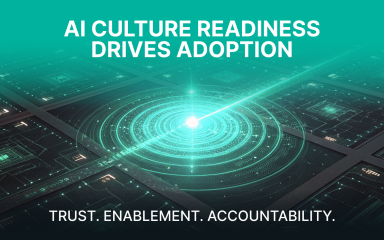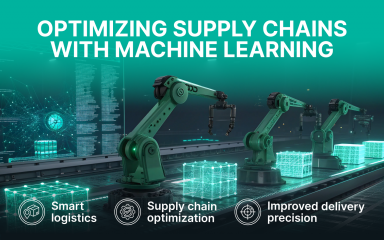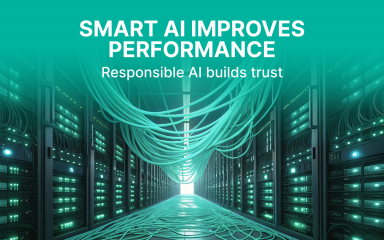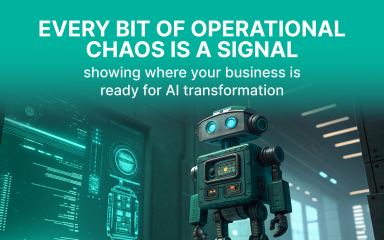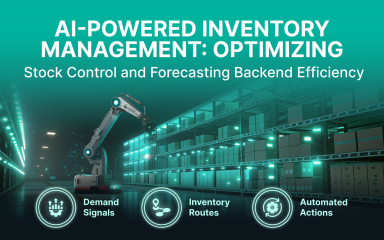AI Development Cost: What It Takes to Build, Scale, and Profit from AI Solutions
How much does AI development cost? Or, more specifically, how much does AI cost when considering different types of projects? It depends on what you’re building — but here’s the short answer:
Artificial intelligence is a broader field that shapes the cost of developing AI solutions. You can build a basic AI proof-of-concept for USD 25,000–50,000, while enterprise-grade AI systems can run USD 500,000+, especially with real-time automation, large-scale data, and high-availability requirements.
This wide range is shaped by factors such as project complexity, team structure, infrastructure, and your starting point, so let’s break it down.
That’s a wide range. And the truth is, it reflects the broad scope of artificial intelligence. Your final AI development cost estimation depends on the scope, infrastructure, data complexity, and team structure of your project.
Let’s dig into the details so you can budget smart — and build AI that actually works.
Key Factors That Influence AI Development Cost
Not all AI development projects are created equal. When planning an AI project, it’s essential to consider the cost of AI software development, software development, and artificial intelligence as key factors. Businesses must also understand the costs associated with AI and the total expenses involved to budget effectively and ensure project success. AI costs encompass a wide range of expenses, including initial development, ongoing maintenance, data management, and other long-term considerations that impact the overall investment. Here’s what really moves the needle:
Project Complexity & Type
The kind of AI solution you’re developing affects everything — timeline, infrastructure, and price.
- AI chatbot development cost is typically lower, especially if you’re starting with existing frameworks.
- AI model development cost for something like a recommendation engine or fraud detection tool can spike significantly due to the need for deeper training and more refined data.
- AI agent development cost — especially when agents are designed for multi-step tasks and autonomy — often comes with additional complexity and testing time.
For example, an AI agent development cost breakdown might include orchestration logic, memory systems, long-term storage, and integrations with external APIs, not just model training.
Infrastructure & Tools
Cloud services, data storage, and compute power are major cost drivers. Ongoing operational costs, such as server maintenance and scaling, are part of the infrastructure expenses that must be factored into your budget.
Team Structure
Are you hiring in-house AI developers or outsourcing to a specialized team?
- In-house AI development offers more control and long-term stability, but usually increases your software development cost due to salaries, retention, training, and the need to assemble a skilled development team.
- Outsourced AI development can reduce costs — particularly for MVPs or short-term projects — but might limit flexibility.
- Hybrid teams — a mix of in-house product leadership and outsourced specialists — often hit the sweet spot for mid-size companies. An effective AI development team typically includes key roles such as data scientists, machine learning engineers, and software developers.
Choosing the right AI development partner is crucial for ongoing collaboration, regular communication, and ensuring the success and alignment of your project.
If you’re building a virtual assistant or voice interface, AI assistant development cost tends to rise due to voice training, speech-to-text processing, and custom intent modeling.
Data Requirements
The amount and quality of data you need can make or break your budget. Extensive data processing is essential for high-accuracy AI applications, especially in real-time or complex scenarios. The development process also includes ensuring data readiness and preparation, which can be resource-intensive.
Understanding these factors will help you estimate costs and plan for successful AI integration as a key step in deploying AI solutions.
The Type of AI You’re Building
Natural language processing? Predictive analytics? A virtual assistant with voice recognition?
- AI chatbot development cost may stay under USD 75k
- AI language model development cost can balloon to USD 500k+
- Computer vision or predictive models sit somewhere in between
The more data and compute your AI model needs, the more you’ll pay.
Infrastructure and Tools
AI software development isn’t just about code. You’ll need:
- Cloud platforms (like AWS, Azure, GCP)
- APIs or SDKs (OpenAI, Cohere, Hugging Face)
- GPU access for training and inference
These infrastructure costs can stack up, especially if you’re building your own AI system from scratch.
Data Readiness
A working AI solution is only as good as its data. Costs include:
- Data collection and data labeling
- Data preparation and cleanup
- Secure storage and access control
If your customer or product data is messy, expect higher development costs just to get started.
Typical Budget Ranges by Project Type
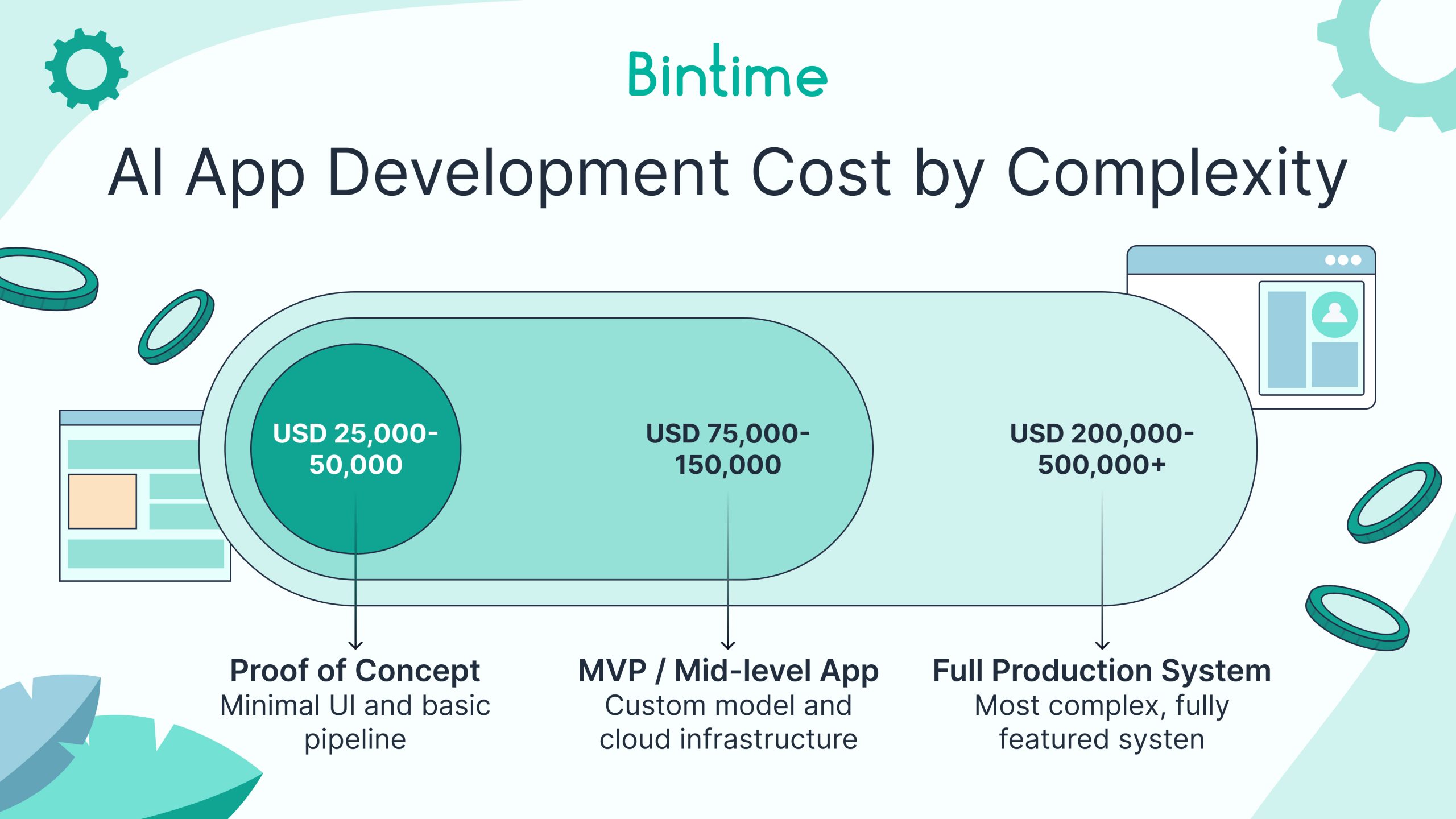 Here’s a rough breakdown of AI app development cost by complexity, based on AI development projects reviewed to illustrate typical budget ranges:
Here’s a rough breakdown of AI app development cost by complexity, based on AI development projects reviewed to illustrate typical budget ranges:
| Project Type | Cost Range | What’s Included |
| Proof of Concept (PoC) | USD 25,000–50,000 | Pre-trained models, minimal UI, basic data pipeline |
| MVP / Mid-level App | USD 75,000–150,000 | Custom AI model development, dashboard, cloud infra |
| Full Production System | USD 200,000–500,000+ | Real-time data pipelines, scalability, AI agents development cost, security, maintenance |
These project types represent comprehensive AI projects, each with varying levels of complexity and scope. The AI software development cost and overall software development cost are influenced by factors such as project complexity, third-party integrations, and the type of solution required.
Adopting a lean AI development approach — such as starting with a Minimum Viable Product — can help keep AI projects cost-effective by focusing on essential features and minimizing unnecessary expenses.
Hidden Costs Most Companies Overlook
You’ve scoped your AI project, assembled your team, and maybe even lined up the tech stack. But then the unexpected invoices start piling up — not because someone dropped the ball, but because some of the biggest AI development costs hide in plain sight.
Let’s unpack the four most overlooked budget busters:
- Training time & compute — long model training = high cloud bills
Training an AI model isn’t a “one-and-done” task. It’s a lengthy and resource-intensive process, particularly for deep learning models. The longer your model trains, the more cloud compute hours you rack up. Add GPU acceleration, and your AWS or Azure bill can jump faster than expected. And that’s just for one version of the model.
Want to fine-tune it again next month? You’re paying all over again.
- Ongoing costs — models decay, data shifts, and retraining is necessary
AI isn’t static. Models drift. User behavior changes. Data gets stale. What worked beautifully in Q1 might underperform by Q3 unless you monitor, retrain, and recalibrate. That means carving out a budget for continuous evaluation, new data collection, and sometimes rebuilding parts of your pipeline.
Ignoring this step is how promising AI systems slowly become expensive shelfware.
- Compliance & data security — especially in retail, finance, or healthcare
Working with personal, transactional, or behavioral data? Welcome to the world of GDPR, HIPAA, CCPA, and other regulations that come with real consequences. Ensuring your AI solution is compliant — and that your models don’t leak sensitive data — often requires legal reviews, privacy audits, encryption protocols, and additional access controls.
Especially in retail, fintech, and healthcare, this is non-negotiable. And it’s rarely cheap.
- Integration with legacy systems — takes time and specialist help
Here’s a classic pitfall: you build a brilliant AI-powered recommendation engine… and then realize it doesn’t sync with your eCommerce backend. Or your CRM. Or your inventory manager.
Suddenly, your team is knee-deep in API spaghetti, custom connectors, and systems integration work you didn’t plan for.
Getting AI agents to work inside existing ecosystems takes time, testing, and specialist help. It’s not the glamorous part of AI development, but without it, your model might never leave the lab.
How to Maximize ROI from AI Development
Let’s not sugarcoat it — AI solutions don’t come out of the box ready to deliver value. They require care, calibration, and smart decision-making. But if you build with intention, the return can be fast, measurable, and genuinely game-changing.
Here’s how to stack the odds in your favor:
- Start Narrow. Win Fast.
The fastest way to blow your AI development budget? Trying to solve everything at once. Instead, pick one high-impact use case, like reducing cart abandonment or forecasting inventory demand. Tackle that first. Nail it.
Early wins help build internal buy-in and show actual value, not just AI “promise.”
- Use What’s Already Trained
Not every project needs a model built from scratch. Thanks to open-source libraries and SaaS platforms, you can often start with pre-trained AI models and fine-tune them to your data.
This move alone can slash your AI app development cost by 30–50%, especially for tasks like sentiment analysis, product classification, or basic virtual assistants.
- Build for Scale — Even If You’re Not There Yet
Maybe your traffic is modest today, but what happens when it doubles? Or triples?
Design your AI system with scale in mind. Use cloud-native architecture, microservices, and modular pipelines. That way, you won’t need to rip everything apart when your MVP attracts real traffic — you’ll just scale up confidently.
- Treat Your AI Like a Garden, Not a Statue
Most teams forget that AI development isn’t a one-time project. Your models will drift, edge cases will appear, and customer behavior will evolve.
To keep your AI solution smart and relevant, you need a system of feedback loops — monitoring tools, retraining schedules, and human oversight.
- Go Lean, Not Perfect
The biggest mistake is chasing perfection from day one. Some of the most profitable AI systems started out as scrappy, bare-bones prototypes.
So instead of aiming for the AI equivalent of a Tesla Cybertruck, focus on building a reliable bike. Then a scooter. Then a car. Your AI development cost stays manageable, and your ROI starts flowing months — not years — after kickoff.
AI Cost vs. Value: Is It Worth It?
Let’s be real — AI development doesn’t come cheap. Whether you’re building a smart assistant, a pricing engine, or a full-scale AI system, the upfront costs can give any CFO heartburn. So, is it worth it?
If — and it’s a big if — your project reaches productization, the answer is a confident yes.
According to McKinsey, AI-driven personalization can lift eCommerce revenue by as much as 15%. But those gains don’t come from shiny prototypes. They come from solutions built, deployed, and continuously refined in the wild.
Let’s break down how the ROI of AI shows up in actual business results:
- Time-to-Value
When scoped with discipline, most AI projects hit positive ROI within 6–12 months. That includes development, testing, deployment, and those crucial early wins that justify the investment.
Move too fast, and you risk building the wrong thing. Move too slow, and the market will outpace you. Smart teams find the balance.
- Revenue Growth
AI isn’t just a cost center — it’s a revenue engine. Real-world examples show that:
- Predictive pricing algorithms can optimize margins in real time.
- Smart inventory management cuts overstocking and understocking issues.
- Personalized product recommendations drive higher AOV and repeat purchases.
Some retailers have seen sales climb 10–20% after implementing targeted AI solutions.
- Cost Savings
Support is another goldmine for ROI. Automating basic queries with AI chatbots or virtual assistants saves roughly USD 0.70–1.00 per customer interaction, and adds up quickly for high-volume businesses.
That doesn’t mean firing your support team. It means freeing them up to handle the complex stuff, while AI handles the FAQs.
So yes, the cost of AI development can initially feel steep. But when you focus on measurable impact and build smart, not just fast, the value more than justifies the investment.
AI isn’t magic. But with the right problem, the right people, and a realistic roadmap, it works.
FAQ: AI Development Cost Explained
How long does it take to develop an AI app?
It really depends on the scope. A simple proof of concept with pre-trained models might take 2–3 months. But if you’re building a custom, enterprise-grade AI system — think automation, real-time data, integrations — you’re likely looking at 6–12 months (or more). The more ambitious the project, the longer the runway.
Can small businesses afford AI?
Absolutely. The idea that AI development is only for giants like Amazon or Google is outdated. Thanks to SaaS tools and pre-trained AI models, even small teams can implement AI-driven features like chatbots, product tagging, or customer analytics. The key is to start with modular, off-the-shelf solutions and scale from there.
What’s more expensive: building or buying AI?
Buying is usually cheaper upfront, especially if you need something fast and fairly standard. Think: AI-powered search, chatbot platforms, or predictive analytics tools.
However, if you require flexibility, control, or unique features, custom AI software development may be worth the higher development cost. It’s a classic “build vs. buy” tradeoff — short-term savings vs. long-term value.
Final Thought
AI development cost isn’t just a line item — it’s a strategic choice. Every dollar spent is a bet on future efficiency, smarter operations, and stronger customer experiences.
Whether you’re testing the waters with a simple chatbot or scaling your eCommerce engine with advanced AI assistants, the real value lies in how well your solution fits your business goals, not just how impressive the tech sounds on paper.
The smartest play? Start small. Measure what matters. Double down on what works.
With clear priorities and the right partners, AI doesn’t just pay for itself — it helps your business grow sharper, faster, and more resilient for what comes next.

